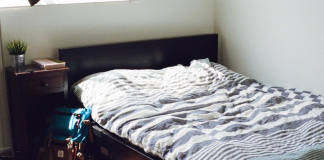Getting your home ready for winter can sometimes feel like a bit of an ordeal. There’s just so much to do. However, you still have a lot of time. There are still several weeks before the cold weather hits, giving you the space you need to unwind from summer and get ready for the ice, rain, snow, and long dark nights.
In this post, we run through some of the easy ways you can prepare your home for winter. Read all about them below.

Check Your Drains And Gutters
During fall, drains and gutters become clogged with leaves, twigs and branches. During dry spells, this isn’t usually a problem. However, the moment the rain comes, you can find yourself in quite a bit of trouble. If gutters and drains are clogged they can’t draw water away from your home, leading to problems like rising damp.
The good news is that it is usually very easy to make your drains fit for purpose. If you have a suitable ladder, you can clean out your gutters yourself. If you’re worried about safety, you can get a handyman to do it for you, usually for a low fee.
Check Your Trees For Loose Branches
Before winter arrives, you’ll also want to check your trees for loose branches. In the northern hemisphere, summer weather tends to be relatively calm. However, in the winter, wind speeds increase. Thus, if any trees on your property have loose branches, they can create a hazard.
You can deal with this relatively easily. Just hire a tree specialist to come over and trim them back for you. Usually, they’ll be able to tell you immediately whether you or your property is at risk of tree fall and what you can do about it.
Please note that many insurers do not cover tree fall. Most consider any damage the responsibility of the owner. It is a good idea to check your policy to see precisely how your insurer will deal with such claims.
Check Your Heating System
It’s been a long hot summer, so the last time you used your heating system was probably many months ago. During that time, it may have degraded and might not work when you switch it on as the weather dips – not what you want.
You can easily preempt this by arranging yearly servicing. Here, boiler specialists come to your home, check all the regular points of failure and then fix anything that might break once the winter arrives. While you will have to pay for servicing upfront, it actually helps to lower your long-run boiler costs. Furthermore, you may get existing life out of your existing boiler if you can put off replacing it into the future.
Cover Your Pool
Unless your pool has a serious heating system, you won’t be using it during the winter. As such, you’ll need to “winterize” it to protect it from damage.
Modern solutions make closing your fiberglass pool relatively easy. However, you will need to consider other factors and costs. For instance, you may need to reduce the water level in your pool. You may also need to skim surface debris, remove any accessories, and add a chemical closing kit.
If you don’t winterize your pool, you can run into all sorts of problems. Organics can enter and take up residence, causing real damage. You can also damage your pump and filtration system. Thus, it’s not something you can avoid doing.
Close Door And Window Drafts
During the summer, drafts don’t matter so much. Usually, the temperature is high enough to negate the need to turn on your heating system. However, once winter rolls around, you’ll need to rely on your heating system more.
Fully-sealed homes are highly energy-efficient. But those with draft spaces around windows and doors are not.
The cheapest way to deal with a door draft is to place a draft blocker along the floor. This will prevent cold air from travelling through the space under the door. You can also try re-caulking window seals to see if that makes a difference.
If you’re not sure whether you have a draft, you can use the candle technique. This involves holding a candle up to the window or door and seeing whether it flickers or not. If there is a draft, the flame will move around. If there isn’t, it will hold still.
Check Your Carbon Monoxide Detector
Checking your carbon monoxide detector is functioning correctly is essential before the winter months arrive. During winter, air changeover in your home decreases because you keep doors and windows shut. Furthermore, you will be using your boiler which can emit CO if it is not working correctly.
You can check whether your carbon monoxide detector is working by pressing the “test” button. When you push it, the device should make a sound. If it doesn’t, then you may need to replace the old battery with a fresh one. If it still doesn’t work, then you will need to replace the entire unit.
Install New Carpets
During the summer, most people want cool tiles underfoot. But in the winter, these can make your home feel unnecessarily cold. You may, therefore, want to install new carpets. If you have the budget for it, opt for thick, fluffy carpets that will feel cosy underfoot. To protect them against damage, you can overlay them with rugs.
Collect Some Firewood
If you haven’t done so already, now is the time to start collecting firewood for your open fire, woodburner or fireplace. The earlier that you can collect wood, the better because it needs time to dry out. If you attempt to burn “green” wood, you’ll produce a lot of smoke and your fire will be disappointing.
You can store firewood in a shelter in the garden. However, for this system to work, you really need to harvest wood before the hot summer arrives. That’s because you need high temperatures to facilitate drying.
If you still want to collect wood for the winter, you may need to bring it inside and keep it somewhere warm. Keeping it next to your fire is probably the best place, as the extra heat generated will help it dry out faster.
Service Your Air Conditioning
After a long summer, your air conditioning system (if you have one) is probably in need of a service. Filters may need replacing and other components, such as fans, will also need checking.
Replacing filters and servicing your HVAC before winter feels like an annoying additional expense. However, it prevents you from having to sort it out in the summer, once the hot weather arrives. Typically, you’ll face lower service prices in winter due to lower demand.
Put Rugs Down On Hard Floors
If recarpeting your home for winter isn’t an option, you might want to try putting down rugs instead. During the winter months, they provide much-appreciated insulation between the floor and the soles of your feet.
Of course, if you already have underfloor heating, then you don’t need to worry so much.
Buy A New Heater
If your central heating is a little lackluster, you often need to supplement it with standalone heaters. So before winter arrives, you might want to go shopping for some.
Electric heaters are the cheapest option. You simply plug these into the socket and switch them on to generate additional heat.
You can also get gas heaters. These are best for large open spaces in your home. However, because of high setup costs, they typically cost more.
The last option is to get a reverse cycle air conditioning unit. In other words, you use your air conditioning to pipe warm exhaust air into your home. This can be a good option for people with large budgets.
Adjust The Colors
With winter on the way, you may also want to change your home’s color palette. In summer, many of us decorate in bright tones that complement the sunny weather. However, when winter hits, we naturally want to make our homes more neutral.
If you want your home to be a little cosier, then you might want to think about adding warmer colors and hues. Olive, orange, cream and lavender can all help in this regard.
Add Winter Coverings To Your Windows
During summer, thin white curtains are great for reflecting sunlight and keeping your interiors cool, but they are terrible at retaining heat in the winter. The solution is to whip out your winter drape collection. Winter curtains are much thicker than their summer counterparts. They are made of material that traps pockets of air, slowing the rate at which warmth escapes when the weather is cold outside.
Conclusion
Preparing your home for winter actually involves more tasks than you might think. It’s not always a straightforward process. However, you can put many of these tasks on autopilot if you accept the help of professionals.
Ultimately, you want your home to provide you with cosiness and warmth. You don’t want it to feel cool and frigid. And you don’t want to allow winter conditions to damage it. These are our top ways to prepare your home for winter – let us know your thoughts!

